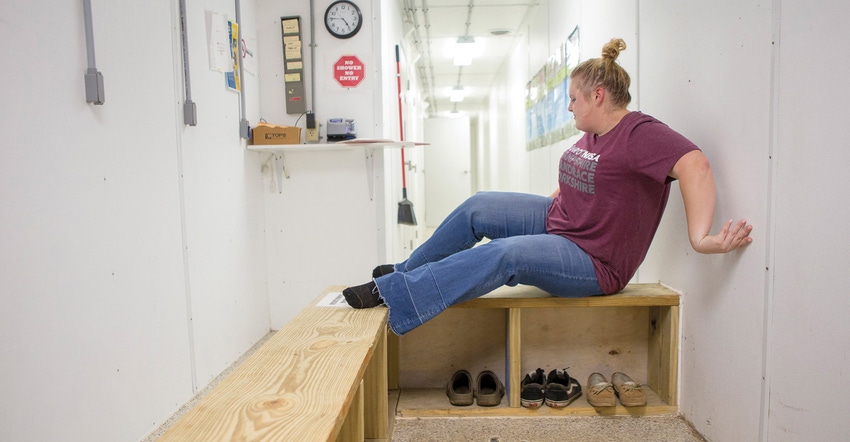5 P’s of biosecurity
The goal in wean-to-market barns is not perfection, but progress.

Around 90% of pork producers associated with PIPESTONE agree that there is a return on investment when it comes to improving biosecurity, however despite that strong passion and understanding, wean-to-market standards are not well defined across the industry, compared to SOPs on sow farms.
“If we do have a set of standards the execution of them is not always done or not always consistent,” says Rachel Stika Jensen, a veterinarian with PIPESTONE, based out of Independence, Iowa. “How often do you see a really nice shower in, shower out wean-to-market barn but that shower is used as a storage closet?”
While precedence and expectation for biosecurity standards has been set at the sow farm, Stika Jensen points out the knowledge and science has been extensive and clear that biosecurity is also critical for wean-to-market barns, and the return on investment can be substantial.
To get a better understanding of producer perception of wean-to market biosecurity, PIPESTONE conducted a survey in the summer of 2022 with 42 producers in its network.
One of the first questions addressed: How much of an impact do biosecurity practices have on health and return on investment when it comes to the sow farm? Ninety-five percent of producers said it has a high impact. However, when that same question was asked, in regard to wean-to-market barns, only 48% of producers thought it had a high impact.
Another question posed was if they have a good understanding of how to implement an effective biosecurity plan in their barns and nearly all were “pretty confident that they would be able to do it,” Stika Jensen says. However producers noted the factors inhibiting them most from being successful were time and convenience, which ranked higher over labor, knowledge and cost.
“It’s more perceived that it's going to slow them down on their chores, it's going to be a hindrance,” Stika Jensen says. “It's not that they don't have the manpower to do it, the knowledge or the money to do it.”
As for ranking key areas for risk of introducing disease into their wean-to-finish barns, the top three high-risk categories were livestock trucks, aerosol and rendering trucks. The surveyed producers put supplies, feed trucks and personnel at the lowest risk.
When asked to rank their biosecurity protocols today, 90% of them either said they were a three, or four, out of five, sitting at average or above average.
The PIPESTONE team then designed an assessment or standardized grading system for its veterinarians to conduct on wean-to-market barns for biosecurity. Seventy-eight total enterprises, encompassing 406 different sites, were enrolled. The highest risk areas according to the assessment were supply entry and personnel entry, both of which ranked low in the previous producer survey.
To improve biosecurity on farm, Stika Jensen suggests looking at the five P’s on site:
Pigs – What is the animal health and vaccination status of the pigs entering your farm? Could you improve animal entry/exit? What is the protocol for animal transport and mortality removal?
People- What are your regulations for visitors entering the farm? Is the feed truck driver wearing booties and following biosecurity procedures on farm? Have you ensured appropriate downtime before entering? Could you improve people entry with a Danish bench system? Have growers received biosecurity training? Twelve producers in the survey mentioned communication and compliance, specifically with contract growers, as a concern. Ten producers suggested training growers, truckers and themselves on protocols and giving continued reminders.
Property- Working with site biosecurity, especially if it is not in an ideal location, involves biosecurity layering. In the survey, nine producers mentioned pig density as a barrier, while eight addressed multi-age and older sites being issues. Another three suggested mapping disease outbreaks for wean-to-market sites. Producers should also review site sanitation practices. Are you washing and disinfecting barns thoroughly, and with hot water?
Products- Do you have equipment and tools dedicated to the site? Is downtime being implemented, for those items coming on farm?
Pests- Are you staying up on bait boxes, fly control, and keeping birds and other pests away?
While the 5 P’s might be a lot to consider for wean-to-market barns, Stika Jensen says producers need to start with simple, slight changes first, and then eventually aim to get to where sow farms are as far as biosecurity standards. She also advises working on high-risk areas first, such as supply entry (disinfection and downtime) and personnel entry and training (Danish bench system, education, hot water hand washing).
She encourages producers to get their Secure Pork Supply plans done, to sign up for AgView and to get staff certified in swine sample collector training, in order to be able to continue business, in the case of a foreign animal disease entering the U.S. swine herd.
“We cannot forget biosecurity is a 24-hour- a-day, seven-days-a-week, 365-days-a-year job, with no days off. Last time I checked diseases do not stop at the end of the sow farm, they keep going,” Stika Jensen says. “Just because you cannot do every step perfectly, that's okay, you must do all that you can. Our goal in the wean-to-market barns is not perfection, but progress.”
About the Author(s)
You May Also Like





